The impact ruptured the ship’s fuel tanks and released approximately four tonnes of fuel oil into surrounding waters. The 230 metre-long bulk coal carrier Shen Neng 1 left the Port of Gladstone bound for China, carrying 68,000 tonnes of coal as cargo.
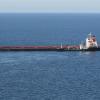
The Sheng Neng 1 at sea - Maritime Safety Queensland
The Chinese-registered ship was traversing a well-known shipping route south of the Douglas Shoal when it ran hard aground 38 nautical miles east of Great Keppel Island at about 5.30pm. The impact ruptured the ship’s fuel tanks and released approximately four tonnes of fuel oil into surrounding waters.
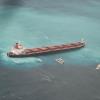
The Sheng Neng 1 after running aground - AMSA
Following an initial assessment, Maritime Safety Queensland (as combat agency) activated National Plan response arrangements. AMSA immediately mobilised key personnel and airlifted a surveyor onto the vessel to carry out damage assessment. Response crews were activated in Brisbane, Gladstone and Rockhampton. Emergency surveillance aircraft were placed on standby to inspect the scene at first light. Oil booms and skimmers were deployed to contain and recover the oil, and dispersants were applied by light aircraft as soon as practicable.
Professional salvors (Svitzer Salvage) were engaged, and boarded the Shen Neng 1 on the morning of 4 April to begin the process of refloating the grounded ship. The initial damage report showed the main engine room was breached, and the main engine and rudder were both damaged. Sea action was causing the ship to move on the reef, creating further damage and increasing the risk of break-up.
Before an attempt could be made to refloat the vessel, oil had to be transferred internally from vulnerable tanks to more secure tanks in order to stabilise the ship and its cargo and minimise the risk of further oil spilling into the water. Following the successful internal transfer, 200-metre lengths of containment boom were placed adjacent to the grounded Shen Neng 1 as an important pollution prevention measure before oil could be pumped off the ship. In the prevailing weather, external oil transfer was a difficult and complex operation. Human safety was the highest priority. By 10 April, 400 tonnes of fuel oil and oily water had been pumped off the Shen Neng I.
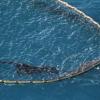
A boom trapping oil on the surface of the ocean – Maritime Safety Queensland
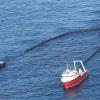
A boom connected to two ships about fifty metres apart – Maritime Safety Queensland
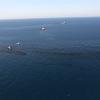
Ships helping clean up spilled oil on the ocean’s surface – Maritime Safety Queensland
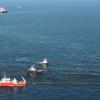
A group of vessels and a boom attempting to clean up spilled oil – Maritime Safety Queensland
Subsequently, Maritime Safety Queensland agreed with a request from the salvors to ‘blow down’ the vessel’s breached tanks with high pressure air to ensure the tanks were clear of oil, before an attempt to lift the grounded vessel commenced. Damage to the ship’s hull caused fuel mixed with seawater to be trapped in hard-to-access tanks, making it difficult to extract all trapped oil. Each tank was sounded and ‘blown down’ separately, with booms in place to contain any oil that may have escaped.
Following this process, the Shen Neng I was successfully refloated at 7.48 pm on Monday 12 April with no loss of oil, and towed to a safe location off Great Keppel Island for further assessment. Inspections by divers showed substantial damage to the bottom hull surrounding the engine room at the stern of the ship, although the ship remained structurally sound overall. Increasingly adverse weather conditions, with south-easterly winds of approximately 25 to 30 knots, prevented extended diving operations and hampered further condition assessments of the hull.
Advice received indicated the ship needed significant repairs and a large amount of coal to be unloaded before it would be safe to tow out of Australian waters.
Following appropriate consultation, a decision was made to tow the ship to the Port of Gladstone where appropriate repairs could be conducted. During this operation, tug crews had difficulty keeping lines secured to the ship. Five thick towing hawsers parted in the rough conditions. Due to the poor handling properties of the ship and unfavourable weather, it was considered too great a risk to attempt to enter the Port of Gladstone for repairs.
On 30 April, AMSA issued a direction for the ship to move to a safe and protected anchorage between the mainland and Fraser Island in the northern reaches of Hervey Bay. On 12 May, with the vessel safely at anchor off Hervey Bay, the coal off-loading operation began. One scoop at a time, 19,000 tonnes of coal were transferred to two lighterage vessels, the Clipper Mistral and Johanna C, to bring the Shen Neng I higher in the water and take the strain off the vessel’s damaged hull in readiness for the long ocean tow. This phase of the response was completed ahead of schedule on May 20, with no coal lost.
Outcome
By 31 May, the Shen Neng 1, towed by a deep sea tug, was on its way back to China, marking the end of a two-month salvage operation.
Related information
Read about Australia's National Plan for Maritime Environmental Emergencies.